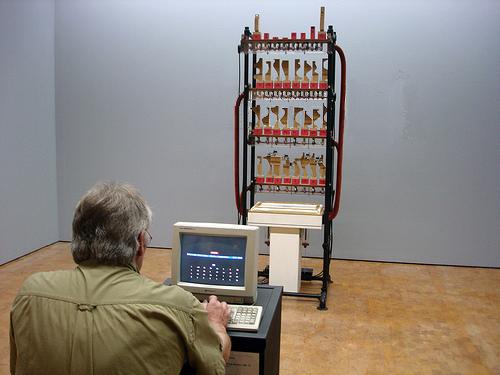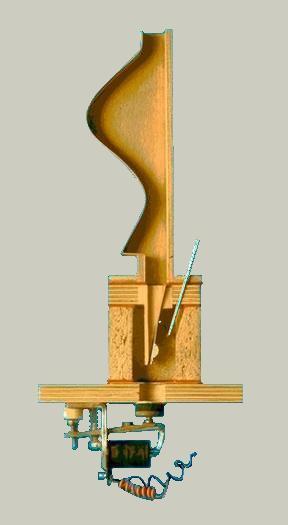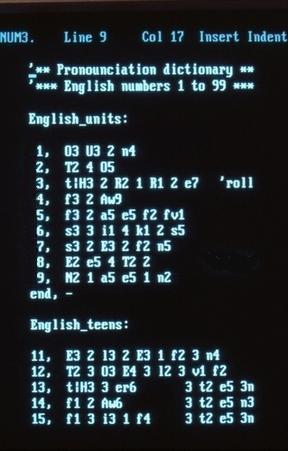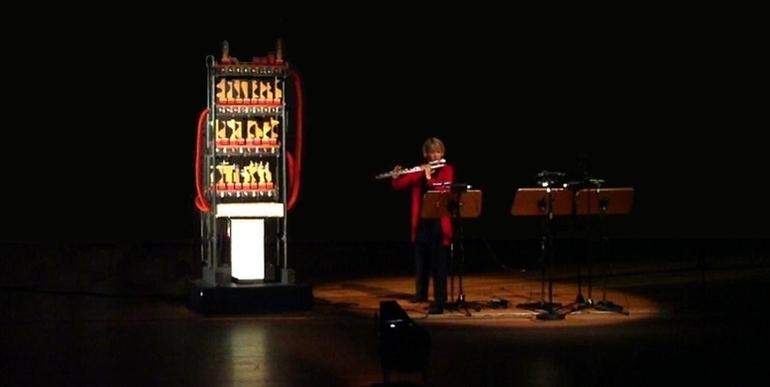
The vowel pipes of the Talking Machine



|
The Talking Machine (1989-1991) 32 pipes and air valves, wind chests, magazine bellows, blower, computer. 230 cm high. The white box at the bottom is a sound-proof casing enclosing the blower. The flat white box above that is a magazine bellows which evens out the air pressure no matter how many pipes are being played. The air goes up the red hoses to the four wind chests which carry the pipes. The wind chests are transparent so the movement of the electromagnetic valves can be seen and this is further reinforced by LEDs attached to each valve. The black cables carry the signals from the computer with the user interface to the valves. |

|
the pipes The pipes on the top row are the fricatives - the hissing sounds - basically, specialised whistles. The two rows below that are mainly vowel sounds but also include vowel-like sounds like W and Y. The lowest row are the remaining consonants. The six pipes in the middle of the row have additional valves to change their sound while it is being spoken and the three pipes on the left have "noses" added to their mouth resonators that enables them to speak the nasal sounds M, N and NG. |

|
a pipe sawn in half
While I was making the machine I accumulated several reject pipes. This is one of them - now used for demonstration purposes. At the bottom is the computer-controlled electromagnetic valve which opens to let the air into the pipe. Above it, in the box, is a metal reed, the equivalent of the vocal cords. It vibrates making a bassoon-like sound and this sound is filtered by the resonator above it, the equivalent of the human mouth, transforming it into a speech sound. |

|
a comparison of the "ee" pipe and a human saying "ee" To pronounce "ee" the tongue goes to the front of the mouth and forms a narrow channel just behind the teeth. The diagram shows the equivalent voice pipe. The reed is made of brass and rests just clear of a leather rim on the spoon-like form of the "kelch". The airflow causes it to vibrate against the kelch. The reed is roughly tuned by a lead weight fixed to its tip. Fine tuning is achieved by means of a wire that can be adjusted to fix the length of reed that is free to vibrate. (These are adaptations of traditional organ-building techniques.) |

|
from the pronunciation dictionary:
English numbers A screenshot of the computer program that governs the order in which the pipes are played and the timing. This page is concerned with English numbers. Each letter represents a pipe; the numbers represent time units. 1, O3 U3 2 n4 To speak the word "one", the pipe named O (which makes an oo sound as in blue) plays for 3 time units. Next, the pipe named U (which makes an uh sound - as in up) plays for 3 time units. Then there is a pause of 2 time units. Finally, the n pipe plays for 4 time units. Result: oo uh - n ... or "one". Sometimes two, or more, pipes play at the same time as in the fv1 at the end of five. |

The machine is usually shown in exhibitions but sometimes takes part in concerts. Here it is in a concert, with Lesley Olson playing SprachMusik by Roland Pfrengle (2008).
Here are the programme notes for a performance How to learn to talk 2U by Tomomi Adachi (2014).